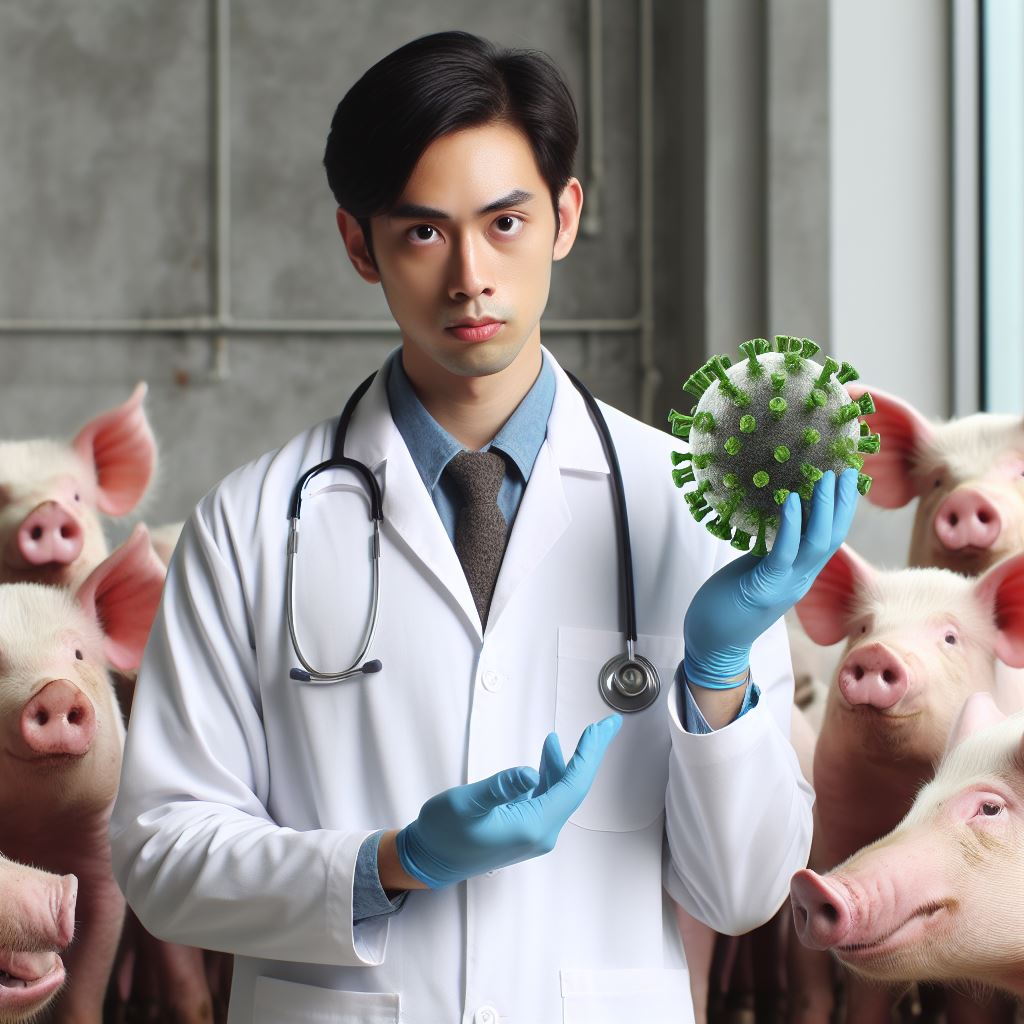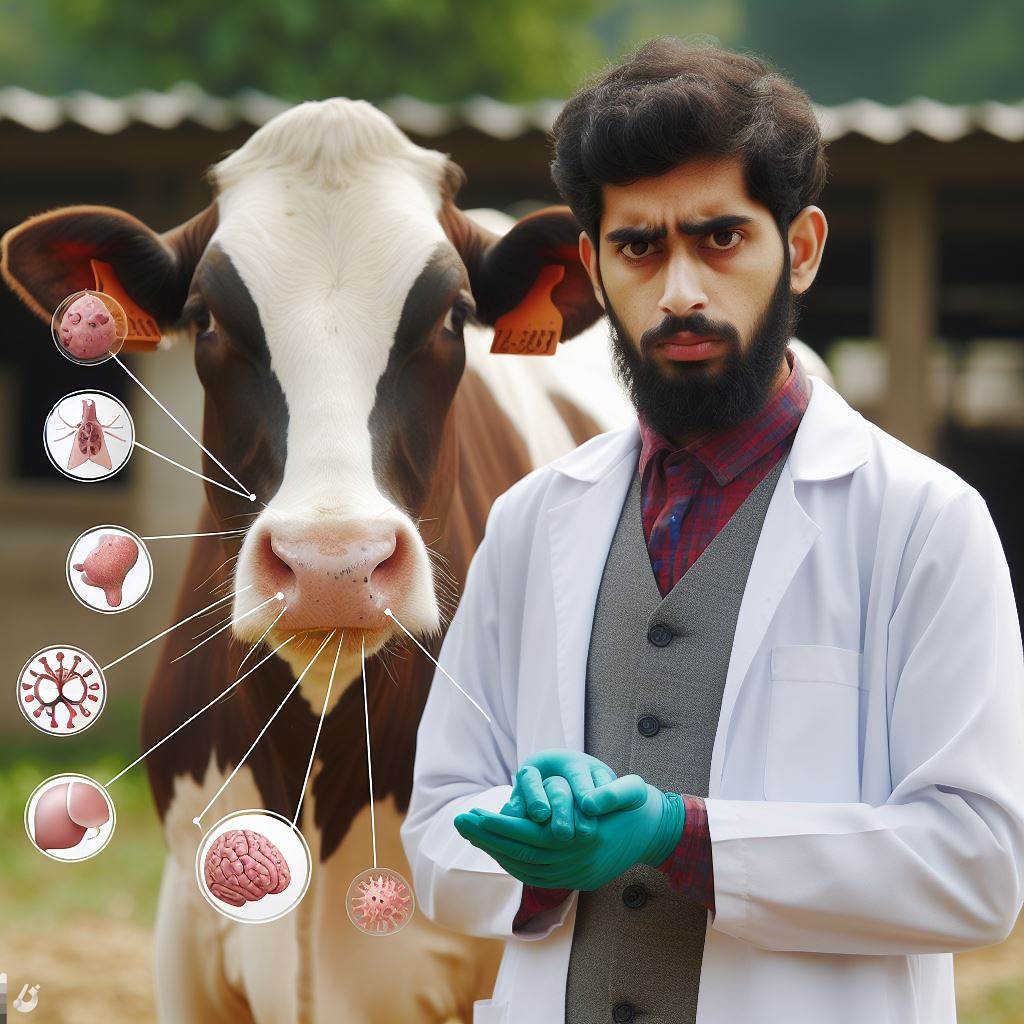Introduction
Brief overview of the importance of sheep flock health
Maintaining the well-being of sheep flocks is paramount for sheep farmers.
Sheep flock health directly affects productivity, profitability, and overall farm management.
As a shepherd, ensuring the health of the flock should be a priority.
Introduction to the common illnesses that affect sheep flocks
Common illnesses among sheep flocks can have significant consequences if not properly addressed.
These diseases spread easily within the flock, leading to reduced productivity and increased mortality rates.
Therefore, it is essential to familiarize ourselves with the common illnesses that affect sheep.
One of the most prevalent illnesses is sheep pneumonia, caused by bacteria, viruses, or a combination of both.
This respiratory disease can spread rapidly, especially in crowded or poorly ventilated areas.
It poses a substantial threat to the flock, resulting in decreased weight gain, lowered milk production, and increased mortality rates.
Another common illness is foot rot, a bacterial infection that affects a sheep’s hoof and surrounding tissues.
Foot rot is highly contagious and often occurs in wet and muddy conditions.
Infected sheep may suffer from lameness, reduced feed intake, and weight loss.
If left untreated, foot rot can cause chronic pain and even death.
Additionally, parasites, such as worms and external pests, can negatively impact sheep health.
These parasites can lead to reduced growth rates, anemia, and overall weakness.
Transform Your Agribusiness
Unlock your farm's potential with expert advice tailored to your needs. Get actionable steps that drive real results.
Get StartedParasite infestations can be particularly challenging to manage and control, requiring routine monitoring and strategic deworming treatments.
Therefore, understanding the importance of sheep flock health and recognizing common illnesses is essential for shepherd success.
By implementing preventative measures and timely interventions, sheep farmers can protect their flocks, maximize productivity, and ensure overall flock well-being.
Prevention and Biosecurity Measures
Importance of implementing preventative measures
- Preventative measures are crucial for maintaining the overall health and well-being of a sheep flock.
- By implementing these measures, farmers can minimize the risk of common illnesses and ensure the longevity of their flock.
- Prevention is always better than cure, and the same principle applies to sheep flock health.
- Investing time, effort, and resources into preventative measures can save farmers from hefty veterinary bills and potential loss of livestock.
- It is essential to prioritize prevention to safeguard the livelihood of not just the flock but also the farmer.
Tips for maintaining good biosecurity practices
- Biosecurity measures are critical to prevent the introduction and spread of diseases within a sheep flock.
- Limiting access to the flock’s premises is the first step towards maintaining good biosecurity.
- Implementing controlled entry points ensures that only authorized personnel enter the area where the sheep are housed.
- Regularly disinfecting footwear and equipment can prevent the transfer of pathogens from one flock to another.
- Strict quarantine protocols should be followed when introducing new animals to the flock.
- Isolating new additions and monitoring them for any signs of illness prevents the spread of diseases.
- Regular veterinary checks are essential to detect and address any health issues early on.
- Vaccinations play a crucial role in preventing common illnesses in sheep and should be administered as per the recommended schedule.
- Cleanliness and hygiene are of utmost importance in maintaining good biosecurity practices.
- Regularly cleaning and disinfecting the premises, feed troughs, and water sources is essential.
- Proper waste management, including the safe disposal of manure, helps control the spread of diseases.
- Educating and training farm staff about biosecurity measures is crucial for effective implementation.
- Everyone involved in the care of the flock should understand the importance of following biosecurity protocols.
- Regularly reviewing and updating biosecurity plans based on new knowledge and recommendations is necessary.
- Collaborating with veterinarians and participating in flock health programs can provide valuable guidance and support.
Maintaining sheep health relies on active prevention and biosecurity.
Implementing these measures minimizes illness risk, ensuring livestock longevity.
Prevention saves on veterinary costs and safeguards livelihoods.
Strict biosecurity, controlling access, quarantine, disinfection, and waste management, prevents disease introduction and spread.
Regular veterinary checks, vaccinations, cleanliness, and hygiene are vital biosecurity components.
Educating staff and regularly updating plans ensure effective implementation.
Prioritizing prevention and biosecurity ensures flock well-being, fostering a thriving sheep farming operation’s success.
Read: Robotics in Poultry Farming: The Future Is Here
Internal Parasites
Overview of the most common internal parasites in sheep
- Haemonchus contortus: Also known as the barber pole worm, it is the most common and deadly internal parasite in sheep. It affects the abomasum and can cause anemia and death if untreated.
- Teladorsagia circumcincta: This parasite primarily affects the abomasum and can cause weight loss, diarrhea, and decrease in productivity.
- Trichostrongylus spp.: These parasites can affect both the abomasum and small intestine, leading to poor growth, reduced feed intake, and respiratory issues.
- Nematodirus spp.: Commonly found in young lambs, these parasites infect the small intestine and can cause diarrhea, dehydration, and even death.
Symptoms, diagnosis, and treatment options
- Symptoms of internal parasite infestation in sheep may include weight loss, poor body condition, pale gums, diarrhea, anemia, and decreased productivity.
- The diagnosis of internal parasites in sheep involves fecal egg count (FEC) testing to identify the presence of parasite eggs in the feces.
- Treatment options for internal parasites in sheep include anthelmintic medications, which can be administered orally, topically, or through injections.
- Anthelmintics such as benzimidazoles, macrocyclic lactones, and amino-acetonitrile derivatives are commonly used to treat internal parasite infections in sheep.
- It is important to follow proper dosing instructions and withdrawal periods when using anthelmintic medications to avoid resistance development and ensure food safety.
- Integrated parasite management strategies, such as pasture rotation, grazing management, and genetic selection for resistance, could also be employed to control internal parasite infestations.
- Regular monitoring of fecal egg counts and working closely with a veterinarian can help in developing an effective parasite control program.
- Additionally, implementing good flock management practices, such as maintaining clean bedding, avoiding overcrowding, and providing proper nutrition, can help prevent the spread and severity of internal parasites.
In essence, internal parasites pose a significant threat to the health and productivity of sheep.
Understanding the most common parasites, their symptoms, and proper diagnosis and treatment options is crucial for maintaining a healthy flock.
By implementing a comprehensive parasite control program, which includes regular monitoring, appropriate treatments, and good flock management practices, sheep farmers can minimize the impact of internal parasites and ensure the well-being of their animals.
Read: Advancements in Veterinary Diagnostic Tools
External Parasites
Introduction to common external parasites affecting sheep
External parasites are a common issue that can affect the health and well-being of sheep.
These parasites can cause a range of problems, from mild irritation to serious health issues.
It is essential for sheep farmers to be aware of these parasites and take preventative measures to keep their flock healthy.
One of the most common external parasites that affect sheep is the sheep tick.
These tiny insects can attach themselves to the sheep’s skin and feed off their blood.
Ticks are most commonly found in areas with heavy vegetation and can transmit diseases to the sheep.
Another common external parasite is the sheep louse. Lice are small insects that live on the sheep’s skin and feed off their blood.
They can cause intense itching and irritation, leading to hair loss and skin damage.
Lice are highly contagious and can spread quickly within a flock.
Showcase Your Farming Business
Publish your professional farming services profile on our blog for a one-time fee of $200 and reach a dedicated audience of farmers and agribusiness owners.
Publish Your ProfileMites are another type of external parasite that can affect sheep.
These microscopic arachnids burrow into the sheep’s skin, causing intense itching and irritation.
Mite infestations can lead to skin infections and distress in the flock.
Symptoms, prevention, and treatment options
It is important for sheep farmers to be able to recognize the symptoms of external parasite infestations.
These can include intense itching, hair loss, irritated skin, and in severe cases, anemia and weight loss.
Regular inspection of the flock’s skin and wool can help detect these signs early.
Prevention is key when it comes to dealing with external parasites in sheep.
Good flock management practices such as regular shearing, proper nutrition, and maintaining a clean environment can help reduce the risk of infestations.
Adequate grooming and hygiene practices, including regular inspections and cleaning of bedding and housing areas, are also crucial.
There are various treatment options available for dealing with external parasites in sheep.
Insecticide sprays and dips can be used to kill ticks, lice, and mites.
These products should be applied according to the manufacturer’s instructions and in compliance with local regulations.
It is important to rotate between different types of insecticides to prevent resistance from developing.
In some cases, oral or injectable medications may be prescribed by a veterinarian to treat severe infestations.
These medications are usually used in conjunction with other management practices to ensure the health and well-being of the flock.
It is important to follow the dosage and administration instructions provided by the veterinarian.
Regular monitoring and follow-up are essential to ensure that the treatment is effective and that the flock remains parasite-free.
It may take multiple treatments to completely eliminate external parasites, depending on the severity of the infestation.
Basically, external parasites can pose a significant threat to the health and well-being of sheep.
Recognizing the common parasites, their symptoms, and implementing proper prevention and treatment measures are essential for maintaining a healthy flock.
By staying vigilant and taking proactive steps, sheep farmers can protect their flock from the detrimental effects of external parasites.
Read: Poultry Diseases: Prevention & Care Tips

Respiratory Diseases
Overview of Common Respiratory Illnesses
Respiratory diseases are a significant concern in sheep flocks and can cause severe health problems.
- Pasteurellosis: This bacterial infection affects the lungs and nasal passages, leading to pneumonia.
- Enzootic pneumonia: It is a contagious disease caused by Mycoplasma ovipneumoniae, affecting young lambs.
- Atypical interstitial pneumonia: A viral disease that causes inflammation in the lungs, often resulting in death.
- Nasal bots: These are larvae of the Oestrus ovis fly that infest the nasal passages, causing irritation.
Symptoms, prevention, and treatment options
Pasteurellosis
- Symptoms: Coughing, rapid breathing, nasal discharge, fever, and decreased appetite.
- Prevention: Regular vaccination, proper ventilation, and maintaining good hygiene in the flock.
- Treatment: Antibiotics prescribed by a veterinarian, isolation of affected sheep, and supportive care.
Enzootic pneumonia
- Symptoms: Coughing, nasal discharge, fever, poor growth, and decreased appetite.
- Prevention: Isolation of affected animals, good flock management, and vaccination.
- Treatment: Antibiotics, anti-inflammatories, and supportive care as directed by a veterinarian.
Atypical interstitial pneumonia
- Symptoms: Rapid breathing, coughing, nasal discharge, and weight loss.
- Prevention: Proper ventilation, reducing stress, and isolating affected sheep from the rest of the flock.
- Treatment: Supportive care, medication to control secondary bacterial infections, and providing a stress-free environment.
Nasal bots
- Symptoms: Sneezing, head shaking, nasal discharge, irritation, and reduced weight gain.
- Prevention: Regular treatment with approved parasiticides and maintaining clean pasture.
- Treatment: Removing the larvae manually, using approved parasiticides, and providing supportive care.
Essentially, respiratory diseases are a significant concern in sheep flocks, risking the overall health and productivity.
Recognizing the symptoms, implementing prevention measures, and seeking effective treatments are crucial for maintaining flock health.
Regular veterinary check-ups and appropriate flock management practices play a vital role in keeping respiratory illnesses under control.
Read: Temperature Control Tech in Livestock Sheds
Metabolic Disorders
Common metabolic disorders in sheep
Hypocalcemia
- A metabolic disorder caused by low calcium levels in the blood.
- Symptoms include poor appetite, weakness, stiff gait, muscle tremors, and difficulty standing.
- Prevention involves a balanced diet rich in calcium, phosphorus, and vitamin D.
- Treatment includes intravenous calcium injections and supportive therapy.
Ketosis
- A metabolic disorder characterized by high levels of ketone bodies in the blood.
- Symptoms include weight loss, poor appetite, lethargy, sweet-smelling breath, and depression.
- Prevention involves providing adequate nutrition during the late stages of pregnancy.
- Treatment includes a balanced diet, drenching with propylene glycol, and supportive therapy.
Acidosis
- A metabolic disorder caused by an accumulation of acids in the rumen.
- Symptoms include reduced appetite, bloating, diarrhea, lameness, and abnormal behavior.
- Prevention involves maintaining a consistent diet and avoiding sudden changes in feed.
- Treatment includes adjusting the diet, administering buffers, and providing supportive care.
Causes, symptoms, prevention, and management techniques
Hypocalcemia
- Causes: Inadequate dietary calcium intake, low vitamin D levels, stress, and hormonal imbalances.
- Symptoms: Weakness, twitching, difficulty standing, muscle tremors, and decreased milk production.
- Prevention: Balanced diet, sufficient sunlight exposure, good management practices, and proper genetics.
- Management Techniques: Calcium supplementation, providing vitamin D, reducing stress, and breeding selection.
Ketosis
- Causes: Inadequate nutrition during pregnancy, sudden increase in energy demands, and high grain diets.
- Symptoms: Weight loss, decreased milk production, ketone smell in breath, and neurological abnormalities.
- Prevention: Proper nutrition during late pregnancy, gradual transition to high energy diets, and monitoring.
- Management Techniques: Balanced diet, propylene glycol drenching, reducing stress, and regular monitoring.
Acidosis
- Causes: Sudden changes in diet, excessive grain consumption, and inadequate fiber intake.
- Symptoms: Reduced appetite, bloating, diarrhea, lameness, and abnormal behavior.
- Prevention: Consistent diet, gradual changes in feed, proper fiber intake, and avoiding excessive grain.
- Management Techniques: Adjusting dietary composition, using buffers, monitoring feed intake, and proper hydration.
In short, metabolic disorders can greatly affect the health and productivity of a sheep flock.
Understanding the common disorders, their causes, symptoms, prevention, and management techniques is essential for sheep farmers.
By implementing proper nutrition, good management practices, and regular monitoring, the risk of metabolic disorders can be minimized, leading to healthier and more productive sheep.
Uncover the Details: Summer Health Tips for Small Ruminants
Reproductive Issues
Overview of common reproductive problems in sheep
- Infections: Ewes may suffer from reproductive tract infections, such as metritis or vaginitis.
- Hormonal imbalances: Problems with hormone production or regulation can result in infertility.
- Poor nutrition: Inadequate diet can lead to poor reproductive health and low fertility in sheep.
- Uterine prolapse: This occurs when the uterus protrudes from the vagina after lambing.
- Retained placenta: Failure to expel the placenta after lambing can lead to infection and infertility.
- Ectopic pregnancies: Embryos implanting outside the uterus can cause health issues and complications.
Causes, symptoms, prevention, and possible treatments
- Infections: These can be caused by bacteria, fungi, or viruses. Symptoms include vaginal discharge, inflammation, and fever. Prevention includes maintaining good hygiene, proper vaccination, and prompt treatment with antibiotics or antifungals.
- Hormonal imbalances: Imbalances may result from nutritional deficiencies, stress, or certain diseases. Symptoms include irregular estrus cycles or anestrus. Prevention involves providing a balanced diet, reducing stress, and consulting a veterinarian for hormone therapy if needed.
- Poor nutrition: Inadequate intake of essential nutrients negatively affects reproductive performance. Symptoms vary but may include delayed puberty, reduced libido, and low conception rates. Prevention requires well-balanced diets tailored to the specific needs of each ewe, supplemented if necessary.
- Uterine prolapse: Risk factors include large lambs, difficult deliveries, and weak uterine muscles. Symptoms include the appearance of a mass protruding from the vulva. Prevention involves careful management during lambing, prompt veterinary assistance, and proper uterine involution after birth.
- Retained placenta: This condition can lead to uterine infections and reduced fertility. Symptoms include a retained placenta longer than 12 hours post-lambing. Prevention includes proper nutrition, hygiene, and prompt veterinary intervention to manually remove the retained placenta.
- Ectopic pregnancies: Causes can be genetic or related to hormonal or inflammatory conditions. Symptoms may vary, from abortion in early pregnancy to dystocia. Prevention is challenging, but proper reproductive management and regular veterinary check-ups can help detect and treat such cases.
Understanding and addressing reproductive issues in sheep is crucial for maintaining a healthy flock and maximizing productivity.
Regular veterinary monitoring, proper nutrition, and prompt treatment are essential in preventing and managing these problems.
Clostridial Diseases
Information on various clostridial diseases affecting sheep
- Clostridial diseases, caused by bacteria of the Clostridium genus, can be deadly for sheep.
- One common clostridial disease is Enterotoxemia, also known as overeating disease.
- Another is Tetanus, which affects the nervous system and can cause stiffness and paralysis.
- Pulpy kidney disease, or enterotoxemia types C and D, affects sheep of all ages.
- Black disease, caused by the Clostridium novyi bacteria, primarily affects lambs and young sheep.
Symptoms, prevention, and vaccination guidelines
- Symptoms of clostridial diseases can vary depending on the specific type and affected organ.
- Some common signs include sudden death, fever, loss of appetite, diarrhea, and lameness.
- To prevent clostridial diseases, maintain proper flock management and hygiene practices.
- Implement a vaccination program to protect sheep from these deadly diseases.
- Consult your veterinarian to determine the most appropriate clostridial vaccines for your flock.
- Vaccinations should preferably be administered in early spring or several weeks before exposure.
- Lambing ewes should be vaccinated approximately four weeks prior to giving birth.
- It is important to follow the recommended vaccination schedule to ensure adequate protection.
- In addition to vaccinations, proper nutrition and a stress-free environment are crucial in preventing clostridial diseases.
- Keep feed and water sources clean and ensure proper sanitation in lambing and housing areas.
- Regularly monitor sheep for any signs of illness or abnormalities and seek veterinary assistance immediately.
- Early diagnosis and prompt treatment can significantly improve the chances of recovery for affected sheep.
- Remember to handle and administer vaccines properly, following the instructions provided by the manufacturer.
- Store vaccines according to their specific requirements to maintain their effectiveness.
- Regularly review and update your flock’s vaccination program based on veterinarian recommendations and any changes in disease prevalence.
Clostridial diseases pose a significant threat to sheep flocks, but with proper knowledge, prevention, and vaccination, their impact can be minimized.
Stay vigilant, follow recommended guidelines, and work closely with your veterinarian to ensure the health and well-being of your sheep.
Conclusion
The health of a sheep flock stands as a linchpin for farm success, ensuring sustained productivity and economic viability.
The imperative lies in recognizing the crucial role veterinarians play in offering tailored guidance.
Consulting with these experts becomes a proactive step toward maintaining the well-being of the entire flock.
The significance of early detection and prompt treatment cannot be overstated, serving as a shield against potential health risks that could jeopardize the flock’s longevity.
Farmers, as stewards, hold the key to fostering an environment where sheep can thrive.
Showcase Your Farming Business
Publish your professional farming services profile on our blog for a one-time fee of $200 and reach a dedicated audience of farmers and agribusiness owners.
Publish Your ProfileThis responsibility goes beyond individual welfare, extending to the broader prosperity of the farm.
By remaining vigilant, seeking expert counsel, and acting decisively, farmers not only safeguard the health of their flock but also contribute to the resilience and success of their farming operations.
In essence, the journey toward a thriving sheep flock encompasses a proactive and collaborative approach that balances expert guidance with the farmer’s commitment to creating a healthy and sustainable farming environment.




